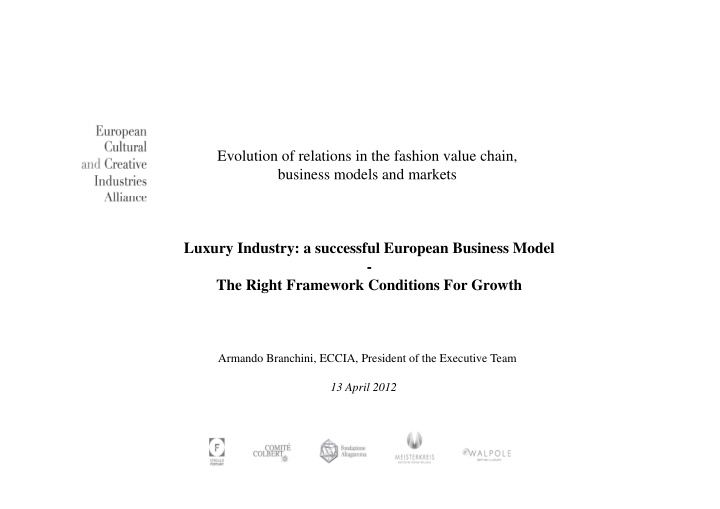



Evolution of relations in the fashion value chain, business models and markets Luxury Industry: a successful European Business Model y y p - The Right Framework Conditions For Growth Armando Branchini, ECCIA, President of the Executive Team 13 April 2012
Luxury Industry: a successful European Business Model The European Cultural and Creative Industries Alliance (ECCIA) is composed of the five major European luxury goods and creative industries organizations: Circulo Fortuny (Spain) Comité Colbert (France) Fondazione Altagamma (Italy) Meisterkreis - Deutsches Forum für Luxus (Germany) Meisterkreis Deutsches Forum für Luxus (Germany) Walpole British Luxury (UK)
Luxury Industry: a successful European Business Model The Personal Luxury Goods Market is a key driver of growth for Europe: 17 of the leading 25 worldwide luxury companies are from the European Union. 170 companies, almost €130 billion in revenues, employing in excess of 1 million people directly and indirectly in Europe More than 70% of the luxury goods produced in Europe are exported outside the region g The European luxury goods sector continues to design and manufacture in Europe.
Luxury Industry: a successful European Business Model The sector grew at 13% between 2009 and 2010 and 10% between 2010 and 2011. C Conservative forecasts of growth of 6%-7% per year to 2014. i f f h f 6% 7% 2014 Strong driver of tourism (Europe n° 1 destination for luxury tourism). Leadership and success on global markets built on European culture and heritage Leadership and success on global markets built on European culture and heritage in designing and creating products. Based on art, culture and creativity, the business model of European luxury companies is underpinned by continuous innovation a relentless focus on quality companies is underpinned by continuous innovation, a relentless focus on quality, highly skilled employment and strong export abroad. The European luxury sector is hence a key driver of sustainable growth and is of particular significance to Europe by contributing to its overall economic health, competitiveness, creativity, innovation, employment and export.
THE RIGHT FRAMEWORK CONDITIONS FOR GROWTH 1. Increase consumer trust to encourage online growth and innovation Same regulatory principles offline & online. S l i i l ffli & li Duty of Care for Online Service Providers. Identity disclosure and no safe harbour protection for service Providers or third Identity disclosure and no safe harbour protection for service Providers or third parties . Clarify scope of injunctions to include pro-active measures against repeat infringers. EU harmonisation of compulsory notice-and-takedown procedures. Outlawing the un-authorised keyword advertising with registered trademarks. Application of the principle of Duty of Care online in order to protect consumers against Unfair Commercial Practices.
THE RIGHT FRAMEWORK CONDITIONS FOR GROWTH 2. Support European growth-driving industries: further foster the specificity of the luxury sector: Recognise the intrinsic value of Intellectual Property for society at large. Safeguard consumer protection and brand values by recognising the benefits Safeguard consumer protection and brand values by recognising the benefits of selective distribution in both sales and after-sales markets, online and offline. Recognise the cultural value of products in policy making Recognise the cultural value of products in policy making.
THE RIGHT FRAMEWORK CONDITIONS FOR GROWTH 3. Support employment: encourage European artisanship and craftsmanship: Putting in place the right initiatives to support these aims, including apprenticeship programmes for artisans and craftspeople Further supporting the coordination among Design and Fashion Universities h i h di i i d hi i i i Encouraging partnerships between public institutions and private business for the development of curricula oriented towards the needs of the job market
THE RIGHT FRAMEWORK CONDITIONS FOR GROWTH 4. Support the export of European products: foster suitable trade platforms Take the specificity of the luxury sector into account in trade negotiations - the excellence that is unique to our values does not generally face local competition in o r e port markets competition in our export markets Strive for trade liberalisation with Free Trade Agreements and enhance visa facilitation to boost third country tourism in Europe
Recommend
More recommend